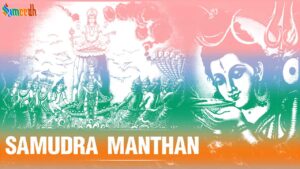The Samudra Manthan, also known as the Churning of the Ocean, is a significant episode in Hindu mythology found in several ancient texts, including the Purans. The story narrates the churning of the ocean by the Devs (celestial beings) and Asurs (demons) to obtain the nectar of immortality (amrit). The churning is a pivotal event that involves the use of Mount Mandara as the churning rod and Vasuki, the serpent king, as the churning rope.

The Samudra Manthan, or the Churning of the Ocean, is a significant episode in Hindu mythology, primarily detailed in the Bhagavat Puran, Vishnu Puran, and the Mahabharat. It symbolizes the struggle between the Dev’s (gods) and Asur’s (demons) for immortality and the divine nectar called Amrit.
It explores themes of cooperation, cosmic balance, and the eternal struggle between good and evil, weaving a tale rich in symbolism and philosophical depth within Hindu cosmology.
The Dev’s (gods) once received a garland from Sage Durvasa. Indra, the king of the Dev’s, placed it on his elephant, Airavata, which then threw the garland on the ground. This act offended Durvasa, who cursed the Dev’s to lose their strength and prosperity.
The Dev’s became powerless and were defeated by the Asur’s (demons). To regain their strength, they approached Lord Vishnu for help. Lord Vishnu advised the Dev’s to form an alliance with the Asuras to churn the Kshira Sagara (Ocean of Milk) to obtain Amrit (the nectar of immortality). Kshira Sagara is believed to be the residence of Lord Vishnu, who lies on the serpent Anant Shesh in a state of cosmic slumber, with Goddess Lakshmi by his side. This ocean is not just a physical entity but also a metaphorical representation of the cosmic energy that sustains the universe and the quest for spiritual enlightenment and immortality.
The Dev’s and Asur’s both agreed, each seeking to gain the nectar for their own benefit. The Dev’s and Asur’s used Mount Mandara as the churning rod. However, the mountain was too heavy and began to sink. To prevent the mountain from sinking, Lord Vishnu took the form of a giant tortoise, the Kurma Avatar, and supported the mountain on his back.
The Serpent King Vasuki, a devotee of Lord Shiv, volunteered to serve as the churning rope. The Dev’s held his tail, and the Asur’s held his head. As they churned, Vasuki’s breath emitted poison. The first outcome of the churning was Halahala, a deadly poison capable of destroying all life. Lord Shiv came to the rescue and swallowed the poison, which turned his throat blue, earning him the name Neelakanth.
As the churning continued, several divine items emerged, including:
- Kamadhenu (the wish-fulfilling cow),
- Airavata (the white elephant),
- Kalpavriksha (the divine tree),
- Kaustubha (a precious gem),
- Apsaras (celestial nymphs).
Eventually, Dhanvantari, the divine physician, appeared holding the pot of Amrit. A fierce battle broke out between Dev’s and Asur’s when the nectar emerged over who would get the Amrit. The celestial bird Garuda took the pot (Kumbh) containing the nectar to protect it In the struggle, a few drops of nectar fell at four locations: Prayagraj (Allahabad), Haridwar, Ujjain, and Nashik, making these sites sacred. The story of the Kumbh Mela originates from the Samudra Manthan and is a central event connected to the Magha Mela. The rivers, especially the Ganges, are considered to be blessed with the purifying properties of this nectar during this time, making the confluence (Sangam) a significant pilgrimage spot.
To prevent the Asur’s from obtaining it, Lord Vishnu assumed the form of a beautiful enchantress, Mohini. She tricked the Asur’s into giving the nectar to the Dev’s. The Dev’s drank the Amrit, regaining their strength and immortality, while the Asur’s realized they had been deceived, but it was too late. With their strength restored, the Dev’s defeated the Asur’s and regained their lost glory. The balance of power was restored, and the universe was saved.
One Asur, named Rahu, disguised himself as a Dev and managed to drink a few drops of amrita before being discovered by the Sun and the Moon. Lord Vishnu beheaded Rahu, but since he had consumed the nectar, he became immortal and his head continued to exist as Rahu. The head, known as Rahu, and the body, known as Ketu, became separate entities. Rahu as an Asur and Rahu as one of the Navagrahas are connected but represent different aspects of the same entity.
This event reinforced the eternal conflict between the Dev’s and Asur’s but established the supremacy of the Dev’s in the heavenly realms.
Symbolism:
- The Samudra Manthan symbolizes the constant struggle between good and evil.
- The poison Halahala represents the hardships and challenges that arise in the pursuit of something valuable.
- Lord Shiv’s act of drinking the poison signifies self-sacrifice for the greater good.
- The treasures symbolize the rewards of perseverance and effort.
The Samudra Manthan is a rich and symbolic narrative with profound spiritual and philosophical meanings. It explores themes of cooperation, cosmic balance, the eternal struggle between good and evil, and the quest for immortality. The story is a testament to the intricate interconnectedness of the Hindu pantheon and the profound symbolism embedded in its myths.